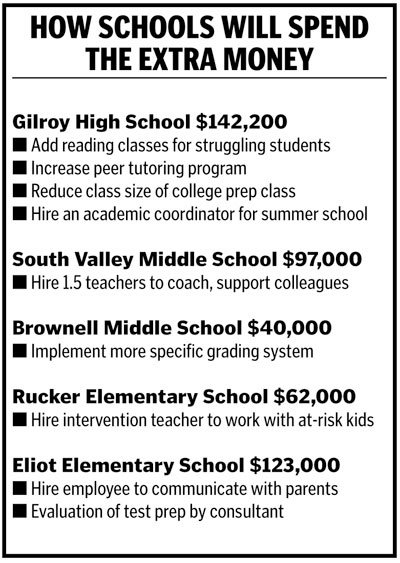Some of the district’s lowest performing schools are likely to
get a total of more than $400,000 to avoid being taken over by the
state and having to replace their entire staff or other drastic
interventions.
Gilroy – Some of the district’s lowest performing schools are likely to get a total of more than $400,000 to avoid being taken over by the state and having to replace their entire staff or other drastic interventions.
However, Brownell’s proposed use for the money has struck some trustees as ineffectual and could delay its funding.
The Gilroy Unified School District board of trustees is set to fund a variety of strategies, from hiring new staff to bringing in an outside consultant to evaluate ongoing test preparation methods, at five schools when it meets Thursday. The $429,000 investment is aimed at bringing the five schools out of program improvement – a federal designation applied when a school has not met testing expectations for two or more consecutive years. The board had previously voiced general approval for plans presented by the principals of Eliot and Rucker elementary schools, South Valley Middle School, and Gilroy High School – all designated program improvement schools. But trustees are divided about a plan to use $40,000 at Brownell Middle School to hire consultants to train teachers to give more specific feedback to students.
“It assumes that teachers now are not telling kids where they’re weak,” trustee Denise Apuzzo said. “I think that’s a bad assumption.”
The consultants would train teachers to use a form that would go out with the quarterly report cards and allow parents and students to focus on areas needing improvement, said Brownell principal Joe DiSalvo. The form would grade individual skills, such as vocabulary and reading comprehension in English that are currently folded into the subject’s letter grade.
“Right now, I think it’s very vague,” DiSalvo said. The form would “be much more strategic and specific in feedback.”
The new system would allow students to focus on a particular area where they are weak, DiSalvo said. As these skills are measured on state tests, student improvement in them will result in a jump in school scores and could bring Brownell out of program improvement.
Even if the new form increased student achievement, it would also unfairly increase teacher workload, Apuzzo said. They would have to spend hours calculating additional grades for scores of students about every three months, but would not receive any additional compensation.
“I don’t think that we can burden these teachers any more,” she said.
DiSalvo disagrees with this assertion, insisting the new form will ultimately decrease teachers’ work because students will have clear direction how to improve.
“I don’t want to increase the workload,” he said. The money “would be to make our work smarter.”
Agreeing with DiSalvo is immaterial, trustee Jaime Rosso said. The board needs to trust its principals to do the job they’ve been hired to do.
“He’s the leader of the school and we have to give them support,” Rosso said.
The board has already expressed approval for the strategies prepared by the other four principals at a May board meeting. South Valley principal John Perales plans to hire the equivalent of 1.5 full time employees to coach its teachers on effective teaching strategies, with the goal of meeting all state testing requirements by 2008 – something it has not done for four years. Similarly, GHS principal James Maxwell will increase reading, leadership and counseling classes targeted at populations such as English-language learners that historically score low on state tests. Rucker and Eliot elementary schools also plan on hiring extra staff to increase attendance and test scores.
Trustees agree that the earlier schools get the money, the better their chances of hiring quality teachers, who are often looking for new jobs in late spring and hired by early summer, according to Marilyn Ayala, director of curriculum and instruction. In addition to this urgency, the funds are specifically set aside to be spent on program improvement schools this year, so the district does not have an incentive to move slowly.
While there is likely to be a debate regarding Brownell’s plan at the board meeting Thursday, as there was at two board meetings last month, the board will ultimately approve a resolution similar to the one presented May 17, Rosso said.
“At this point, I think it’s going to pass simply because there’s a lot of bigger fish to fry and we’ve got to keep going,” he said.














